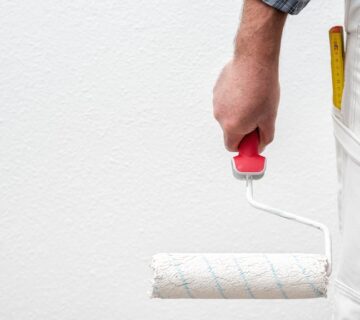The impact of a well-executed paint job on your home’s aesthetic and market value cannot be overstated. Whether you’re preparing to sell or simply refreshing your living space, the quality of the paint work plays a crucial role. Avoiding common house painting mistakes is key to enhancing your home’s appeal and ensuring that it looks its best. In this guide, we’ll delve into common pitfalls in house painting and provide insights on how to achieve a flawless finish that elevates the beauty and value of your home. Painting your home is more than just applying color to walls; it’s about creating an atmosphere and making a statement. A well-chosen paint color can enhance architectural features, highlight design elements, and evoke certain moods or emotions.
Straight Lines: Mastering the Art of Precision
Achieving straight lines is essential for a polished look, but it’s also a common challenge in house painting. Even seasoned painters can face difficulties in creating crisp, clean lines, which can significantly affect the overall appearance of a room. The secret to overcoming this challenge lies in mastering taping techniques and maintaining a steady hand during the painting process. For those who want guaranteed precision, hiring a professional painter with a proven track record in meticulous execution can be a worthwhile investment. With careful attention to detail and proper technique, you can achieve sharp lines that enhance the visual appeal of your home’s interior or exterior.
Peeling Paint: Understanding and Addressing the Causes
Peeling paint is a common issue that can diminish the look of your home. Several factors may contribute to this problem, such as insufficient surface preparation, exposure to moisture, or using incompatible paint types. To tackle this issue effectively, it’s vital to pinpoint the root cause and apply the correct repair methods and materials. Proper initial preparation and selecting suitable paint products are crucial to prevent peeling and ensure long-lasting results. By addressing these factors, you can maintain the integrity and appearance of your home’s paintwork, preserving its beauty and protecting it from deterioration over time.
Preventing Drips and Splatters: A Clean Approach to Painting
Drips and splatters are not only annoying but can also ruin the smooth finish of your paint job. To avoid these common mistakes, precise preparation and skillful application are necessary. Using quality tools and techniques, such as properly loading the brush or roller, helps minimize the risk of mess. Additionally, safeguarding your furniture and flooring with drop cloths or plastic sheeting is critical to maintaining a clean work area throughout the painting process. By adopting a methodical approach and taking necessary precautions, you can achieve a flawless finish without the hassle of dealing with drips and splatters.
The Importance of Proper Preparation
The foundation of any excellent paint job lies in thorough and careful preparation. This process involves cleaning the walls, sanding any rough areas, caulking cracks, and priming surfaces as necessary. Skipping any of these crucial steps can lead to disappointing results and affect the longevity of your paint job. By taking the time to prepare properly, you ensure that the paint adheres well and looks impressive, ultimately transforming the appearance of your home’s interior or exterior. Proper preparation sets the stage for a successful paint job, ensuring that your efforts result in a beautiful and durable finish that enhances your home’s overall appeal.
Final Thoughts
Addressing common painting mistakes is essential for homeowners aiming for perfection in their renovation projects. By focusing on precision, proper preparation, and meticulous application, you can achieve a stunning and enduring paint finish. Remember, a flawless paint job not only enhances the beauty of your home but also contributes significantly to its overall value. Whether you decide to tackle the project yourself or hire professionals, the effort put into doing it right will pay off in the long run, leaving you with a home that you can be proud of for years to come. For further guidance and to avoid common house painting mistakes, consider visiting Sisu Painting and exploring the wealth of resources available at Sisu Painting’s blog.





Thanks for sharing such great information. This is really help to me.
I followed your blog. So please share these types of information in future.
I am glad to read your post! These are fantastic tips to decorate your home.
Great content. This is an eye opening for some painters. Thanks for sharing this.
One small thing can change the whole way your paint job will turn out and how long it will last for. Thanks for sharing this great info with everyone.
Thanks for sharing this post. Just scrolling the internet for material to research,… We have recently started our own home painting business, so I appreciate you taking the time to educate on some of the points above – I am very much still learning the craft myself so thank you! I think I may go back and read some of your old posts as well!
If there are any other blogs or resources for someone new to the industry would love to hear. Have a great day!
Very nice of you to share this kind of content. My husband and I are going to change some rooms with a new look in our house, therefore, those tips are really useful for us. We are residents of Waltham ma, we are blessed with our 2 children! Thank god, hope that we will get over with this new year and home remodel! Just a little nervous about how to decor. Thanks! ~Thomy~
Nancy, thanks for taking the time to put together this helpful article. It’s true that painting is a job that requires more detail than it seems at first – it’s worth hiring a professional who doesn’t skimp. From the perspective of an interior painting and from a consumer’s, this article has so much value.
Hi Nancy! This post was so informative, especially for new business owners such as myself. I appreciate the time you took to put together these tips for painting. It was a very helpful article. Great work!
Thanks for sharing this post. I appreciate all the details inclined in this post that helps me a lot to avoid the common causes that painters make. Great work!
Thanks for sharing this post. I appreciate all the details inclined in this post that helps me a lot to avoid the common causes that painters make. Great work!…………
I really like what you mentioned about lack of appropriate primer can cause problems. Choosing an appropriate primer must be wise and I’d suggest to do the research on the appropriate boston house painters. In my case, my friend in Waltham ma have recommended me to use Sherwin Williams. He said that he has used this paint for over 10 years and never let him down yet.
Preparation might take time but, it will help to create a worthwhile result.
Extremely helpful, thanks for sharing.
Your information is fantastic and I will send future clients to your blog! So many customers don’t understand the importance of high quality prep work. They try to touch up or paint a huge space without proper prep and their result isn’t good. I love serving my clients but if they want to save money and do it themselves they need to understand how to do it right. Your writing on paint peeling is perfect. I’ve had to fix so many walls in my career.
Thank you for bringing professionalism and quality to the industry! I’ll be reading more for sure.
Thanks for sharing. It’s great to know that some painters with 20 years of experience that still haven’t learned to paint a straight line. We recently started our painting company, we are licensed an insured to do exterior and boston house painters, also provide wood staining/resurfacing services around massachusetts area if needed. We have a hard time getting new customers, spend most of my money on marketing with no success. So we really need a professional advice, we will be really appreciated to contact you soon. Thanks for sharing!
It’s great to know that some painters with 20 years of experience that still haven’t learned to paint a straight line. We recently started our boston house painters company, we are licensed an insured to do exterior and interior works, also provide wood staining/resurfacing services around Massachusetts area if needed. We have a hard time getting new customers, spend most of my money on marketing with no success. So we really need a piece of professional advice, we will be really appreciated to contact you soon.
Thank you for educating us! We have had problems also with paint peeling, and we hate to admit it, but there are some of those 3 that you have mentioned that we have done once or twice. Looks like we will need to call back our clients so we don’t get a bad reputation in the painting world! Thanks again for all the advice.